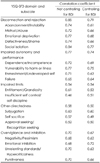Abstract
Objectives
Early maladaptive schemas (EMS) are assumed to be stable emotional and cognitive patterns that begin early in our development and are repeated throughout life. The primary aim of this study was to examine the two-year stability of EMS using the Young Schema Questionnaire (YSQ). In addition, we investigated the relationship between EMS and depressive symptoms over time.
Methods
Seventy-nine medical students completed the YSQ-short form 3, the Beck Depression Inventory, and the Symptom Checklist-90-Revised during their first and third years of medical school.
Results
After controlling for depression severity, YSQ subscales showed significant test-retest correlations for all of the subscales (r between 0.49 and 0.77, ps<0.001). Mean scores for all of the subscales did not differ significantly at retest, with the exception of a significant reduction of vulnerability to harm/illness (t=3.71, p<0.001). Concerning the relationship with depression, some YSQ subscales showed association with the severity of depressive symptoms at each time point, as well as changes between two time points. In particular, the schemas of Defectiveness/Shame and Dependence/Incompetence showed a strong association with changes of depressive symptoms.
Figures and Tables
Table 1
Zero-order and partial correlation between the test and re-test for the domains and subscales of YSQ-SF3

References
1. McGinn LK, Young JE. Salkovskis PM, editor. Schema-focused therapy. Frontiers of cognitive therapy. 1996. New York: Guilford;182–207.
2. Young JE, Klosko JS, Weishaar ME. Schema therapy: a practitioner's guide. 2003. New York: Guilford.
3. Young JE, Weinberger AD, Beck AT. Barlow DH, editor. Cognitive therapy for depression. Clinical handbook of psychological disorders: A step-by-step treatment manual. 2001. 4th ed. New York: Guilford;264–308.
4. Schmidt NB, Joiner TE, Joung JE, Telch MJ. The schema questionnaire: investigation of psychometric properties and the hierarchical structure of a measure of maladaptive schemas. Cognit Ther Res. 1995. 19:295–321.
5. Lee CW, Taylor G, Dunn J. Factor structure of the schema questionnaire in a large clinical sample. Cognit Ther Res. 1999. 23:441–451.
6. Baranoff J, Oei TP, Cho SH, Kwon SM. Factor structure and internal consistency of the Young Schema Questionnaire (Short Form) in Korean and Australian samples. J Affect Disord. 2006. 93:133–140.
7. Soygüt G, Karaosmanoğlu A, Cakir Z. [Assessment of early maladaptive schemas: a psychometric study of the Turkish young schema questionnaire-short form-3]. Turk Psikiyatri Derg. 2009. 20:75–84.
8. Zuroff DC, Blatt SJ, Sanislow CA 3rd, Bondi CM, Pilkonis PA. Vulnerability to depression: reexamining state dependence and relative stability. J Abnorm Psychol. 1999. 108:76–89.
9. Trzesniewski KH, Donnellan MB, Robins RW. Stability of self-esteem across the life span. J Pers Soc Psychol. 2003. 84:205–220.
10. Rijkeboer MM, van den Bergh H, van den Bout J. Stability and discriminative power of the Young Schema-Questionnaire in a Dutch clinical versus non-clinical population. J Behav Ther Exp Psychiatry. 2005. 36:129–144.
11. Riso LP, Froman SE, Raouf M, Gabel P, Maddux RE, Santorelli NT, et al. The long-term stability of early maladaptive schemas. Cognit Ther Res. 2006. 30:515–529.
12. Cockram DM, Drummond PD, Lee CW. Role and treatment of early maladaptive schemas in Vietnam Veterans with PTSD. Clin Psychol Psychother. 2010. 17:165–182.
13. Evans J, Heron J, Lewis G, Araya R, Wolke D. ALSPAC study team. Negative self-schemas and the onset of depression in women: longitudinal study. Br J Psychiatry. 2005. 186:302–307.
14. Wright MO, Crawford E, Del Castillo D. Childhood emotional maltreatment and later psychological distress among college students: the mediating role of maladaptive schemas. Child Abuse Negl. 2009. 33:59–68.
15. Welburn K, Coristine M, Dagg P, Pontefract A, Jordan S. The Schema Questionnaire-short form: factor analysis and relationship between schemas and symptoms. Cognit Ther Res. 2002. 26:519–530.
16. Derogatis LR, Rickels K, Rock AF. The SCL-90 and the MMPI: a step in the validation of a new self-report scale. Br J Psychiatry. 1976. 128:280–289.
17. Kim KI, Kim JH, Won HT. Korean Manual of Symptom Checklist. -90-Reversion. 1984. Seoul: Chungang Aptitude Publishing Co. Ltd.
18. Beck AT, Ward CH, Mendelson M, Mock J, Erbaugh J. An inventory for measuring depression. Arch Gen Psychiatry. 1961. 4:561–571.
19. Lee YH, Song JY. A study of the reliability and the validity of the BDI, SDS, and MMPI-D scales. Korean J Clin Psychol. 1991. 10:98–113.
20. Wang CE, Halvorsen M, Eisemann M, Waterloo K. Stability of dysfunctional attitudes and early maladaptive schemas: a 9-year follow-up study of clinically depressed subjects. J Behav Ther Exp Psychiatry. 2010. 41:389–396.
21. Cohen J. Statistical power analysis for the behavioral sciences. 1988. New Jersey: Lawrence Erlbaum.
22. Abramson LY, Metalsky GI, Alloy LB. Hopelessness depression: a theory-based subtype of depression. Psychol Rev. 1989. 96:358–372.
23. Arieti S, Bemporad JR. The psychological organization of depression. Am J Psychiatry. 1980. 137:1360–1365.
24. Beck AT. Cognitive models of depression. J Cogn Psychother. 1987. 1:5–37.
25. Blatt SJ. Singer JL, editor. Interpersonal relatedness and self-definition: Two personality configurations and their implications for psychopathology and psychotherapy. Repression and dissociation: Implications for personality theory, psychopathology and health. 1990. Chicago: University of Chicago Press;299–335.
26. Roberts BW, DelVecchio WF. The rank-order consistency of personality traits from childhood to old age: a quantitative review of longitudinal studies. Psychol Bull. 2000. 126:3–25.




 PDF
PDF ePub
ePub Citation
Citation Print
Print





 XML Download
XML Download